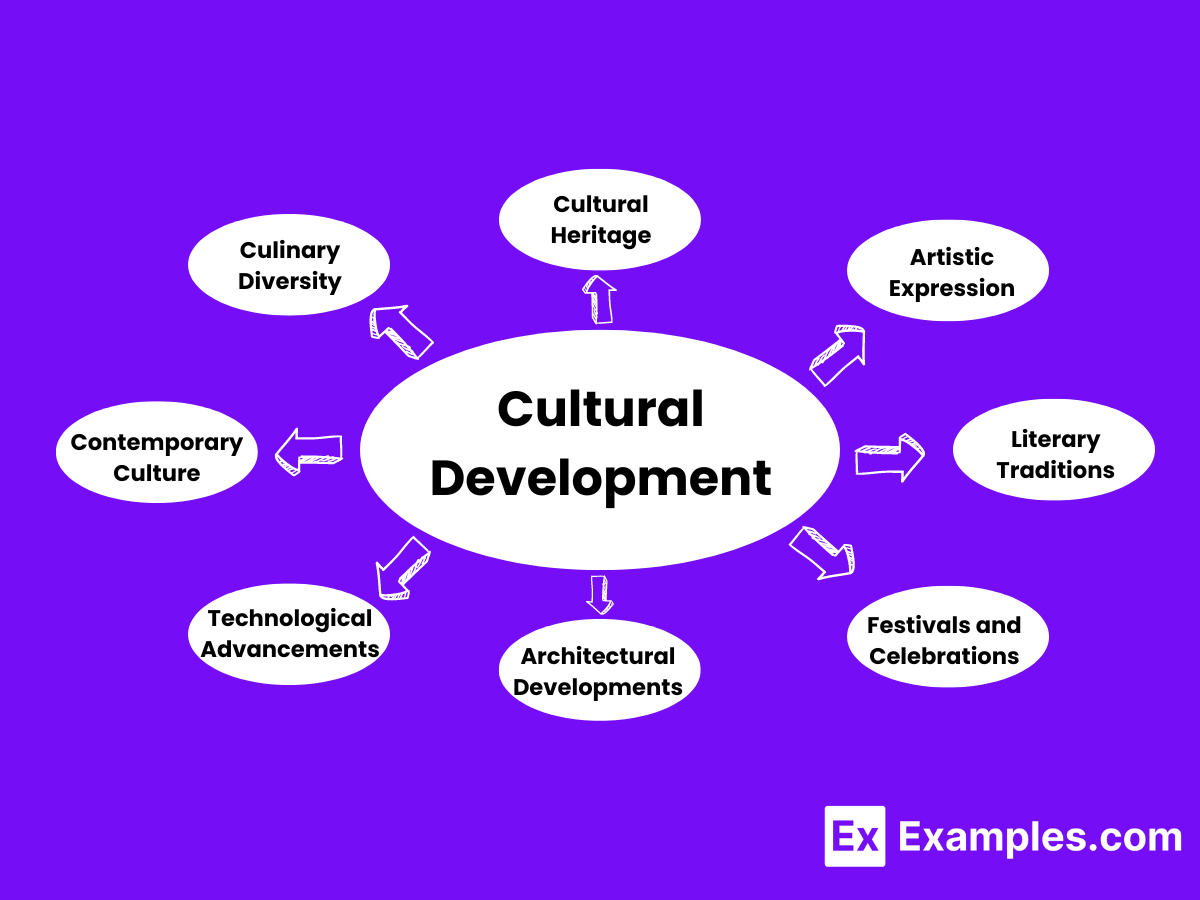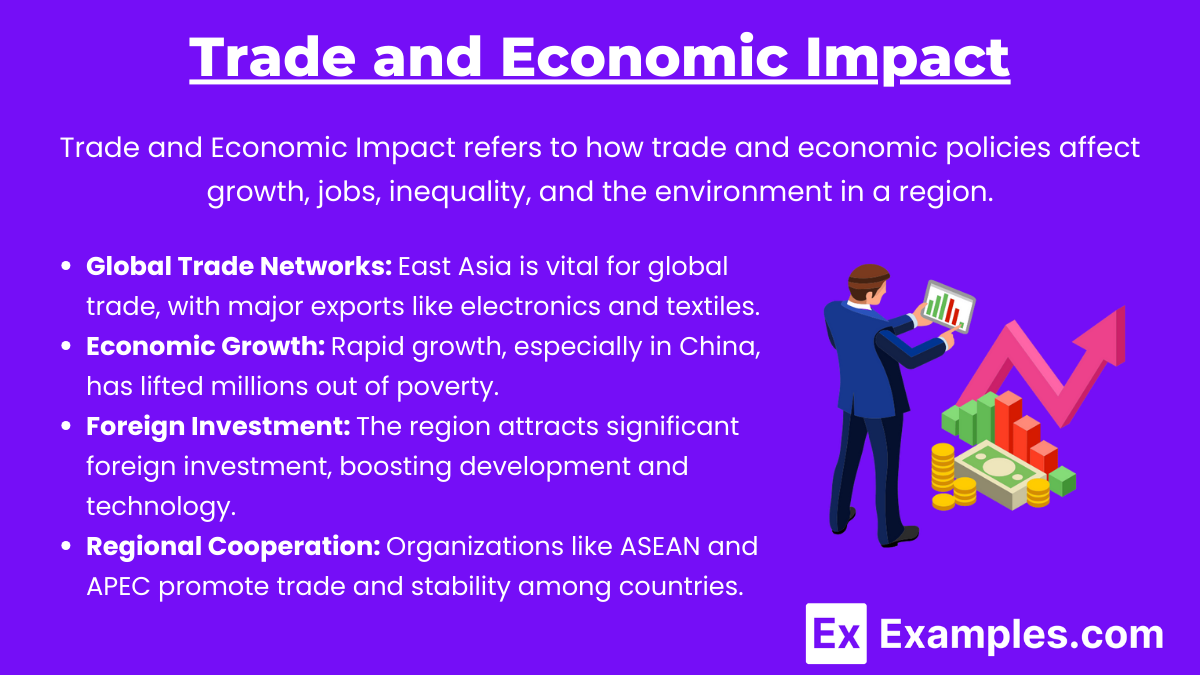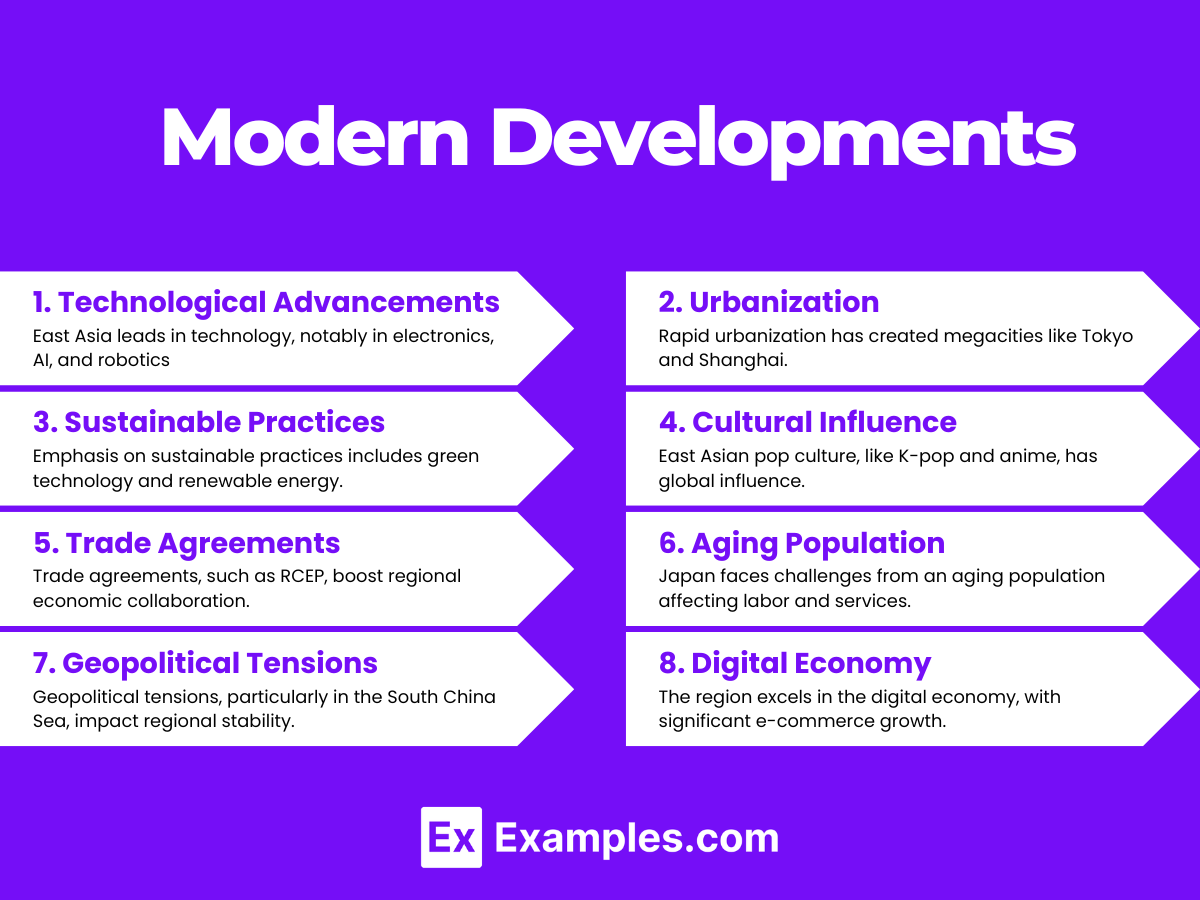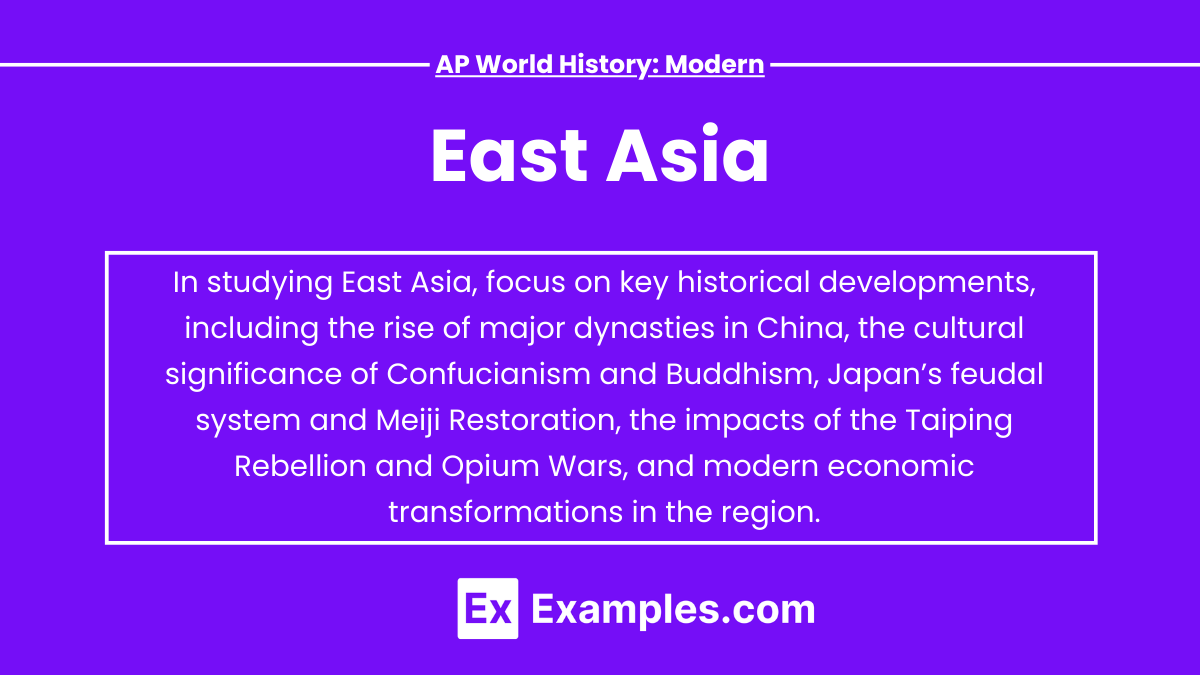East Asia, encompassing countries such as China, Japan, Korea, and Mongolia, has been a crucial player in global history and culture. This region is characterized by its rich cultural heritage, diverse philosophies, and significant technological advancements. Major historical events, such as the rise and fall of powerful dynasties in China and Japan’s transformation during the Meiji Restoration, have shaped its societal structures. Today, East Asia remains influential in global economics, politics, and cultural exchanges, making it a key area of study in world history.
Learning Objectives
When studying “East Asia” for AP World History: Modern, focus on key objectives such as understanding the geographical influences on societies in China, Japan, Korea, and Mongolia. Examine the significance of major Chinese dynasties, the role of Confucianism, Daoism, and Buddhism, and the impact of the Meiji Restoration in Japan. Analyze the Taiping Rebellion and the Opium Wars, and explore East Asia’s interactions with Western powers. Finally, assess the implications of China’s economic reforms and Japan’s post-World War II growth on contemporary global dynamics.
1. Geographical Significance

- East Asia is rich in natural resources, including coal, oil, and rare earth minerals, significantly contributing to the region’s economic development.
- The region experiences varied climates, from tropical in the south to subarctic in the north, impacting agriculture, biodiversity, and settlement patterns.
- East Asia’s strategic location along major trade routes, including the South China Sea, facilitates international trade and economic integration with other regions.
- Natural features such as mountains and rivers influence political boundaries and relationships between countries, leading to territorial disputes in some areas.
- East Asia is prone to natural disasters like earthquakes, tsunamis, and typhoons, necessitating robust disaster preparedness and response strategies.
- The region has a rich history of cultural exchange influenced by trade, migration, and historical interactions, shaping languages, religions, and traditions.
- Rapid industrialization has led to environmental issues, including air pollution and habitat loss, highlighting the need for sustainable development practices.
- East Asia’s geopolitical significance is underscored by its role in global politics, with major economies like China, Japan, and South Korea influencing regional and global affairs.
2. Cultural Developments

Cultural Developments refer to the evolution and transformation of a society’s beliefs, practices, art, and social structures over time. This includes advancements in areas such as literature, philosophy, art, music, and technology, reflecting changes in values, social norms, and interactions with other cultures. Cultural developments shape identity, influence social behavior, and contribute to the overall progress of a civilization.
- Cultural Heritage: East Asia is renowned for its rich cultural heritage, including traditional practices in art, literature, and philosophy, with significant influences from Confucianism, Buddhism, and Taoism.
- Artistic Expression: Chinese calligraphy and painting are highly valued art forms, emphasizing aesthetics and cultural expression, while Japanese arts include ikebana (flower arranging) and tea ceremonies.
- Literary Traditions: The region has a long history of literature, with classical texts such as “The Tale of Genji” in Japan and “The Book of Songs” in China, showcasing deep cultural narratives.
- Festivals and Celebrations: Festivals like the Lunar New Year and the Mid-Autumn Festival celebrate cultural traditions, family gatherings, and agricultural cycles across East Asian countries.
- Architectural Developments: Architectural developments include iconic structures like pagodas in China and shrines in Japan, reflecting historical and spiritual significance.
- Technological Advancements: East Asia has contributed significantly to technological advancements, such as papermaking and printing, which have influenced global communication and culture.
- Contemporary Culture: Contemporary pop culture, including K-pop, anime, and film, has gained international popularity, shaping global entertainment trends and cultural exchanges.
- Culinary Diversity: The region’s culinary diversity, characterized by distinct flavors and cooking techniques, highlights the interplay of geography, history, and cultural practices.
3. Trade and Economic Impact

Trade and Economic Impact refers to the effects that trade activities and economic policies have on a region’s economy, society, and environment. It encompasses the benefits of trade, such as increased economic growth and job creation, as well as challenges like income inequality and environmental degradation. This impact can shape cultural exchanges and influence regional cooperation among countries.
- Global Trade Networks: East Asia is integral to global trade, with major economies like China, Japan, and South Korea exporting electronics, machinery, and textiles.
- Economic Growth: The region has experienced rapid economic growth, particularly in China, where industrialization has lifted millions out of poverty and improved living standards.
- Foreign Investment: East Asia attracts significant foreign direct investment (FDI), driving economic development and facilitating technological advancements.
- Regional Cooperation: Organizations such as ASEAN and APEC enhance trade relationships and economic collaboration among member countries, promoting stability and growth.
- Cultural Exchange: Trade in East Asia has led to cultural exchanges, introducing new ideas, technologies, and practices that enrich local cultures.
- Environmental Concerns: The rapid economic growth has resulted in environmental challenges, including pollution and resource depletion, raising the need for sustainable practices.
- Income Inequality: Economic growth has also led to increased income inequality within and between countries in the region, contributing to social tensions.
4. Modern Developments

- Technological Advancements: East Asia is a leader in technology, with innovations in electronics, artificial intelligence, and robotics, particularly in countries like Japan and South Korea.
- Urbanization: Rapid urbanization has transformed cities, leading to megacities like Tokyo and Shanghai, which are hubs for finance and culture.
- Sustainable Practices: There is a growing emphasis on sustainable development, with initiatives focused on green technology and renewable energy to combat environmental issues.
- Cultural Influence: East Asian pop culture, including K-pop, anime, and films, has gained global popularity, shaping trends and cultural exchanges worldwide.
- Trade Agreements: New trade agreements, such as the Regional Comprehensive Economic Partnership (RCEP), enhance economic collaboration and integration in the region.
- Aging Population: Countries like Japan face challenges related to an aging population, impacting labor markets and social services.
- Geopolitical Tensions: Ongoing geopolitical issues, such as tensions in the South China Sea and relations with North Korea, influence regional stability and security dynamics.
- Digital Economy: The region is at the forefront of the digital economy, with high internet penetration and e-commerce growth, especially in China.
Examples
Example 1 : The Great Wall of China
The Great Wall of China is an iconic symbol of Chinese civilization, originally built to protect against invasions from nomadic tribes. Spanning thousands of miles, it represents the ingenuity and determination of various Chinese dynasties. The Wall also reflects the historical emphasis on defense and the consolidation of power within the region.
Example 2 : Confucianism
Confucianism, founded by Confucius in the 5th century BCE, has profoundly influenced East Asian societies, particularly China, Korea, and Japan. This philosophical system emphasizes ethics, family loyalty, and social harmony. Confucian ideals have shaped government structures, education, and cultural values, promoting a society based on respect and moral integrity.
Example 3 : The Samurai in Japan
The samurai were the warrior class of feudal Japan, known for their code of honor, discipline, and martial skills. Emerging during the Heian period, they played a crucial role in Japanese history, influencing governance and culture. The samurai’s legacy continues to shape modern Japanese identity and cultural practices.
Example 4 : The Taiping Rebellion
The Taiping Rebellion (1850–1864) was one of the deadliest civil wars in history, occurring in China. Led by Hong Xiuquan, who claimed to be the younger brother of Jesus Christ, the rebellion sought to establish a utopian society based on his interpretations of Christianity. The conflict highlighted social unrest, economic hardship, and dissatisfaction with the Qing Dynasty, ultimately leading to millions of deaths and significant political changes.
Example 5 : China’s Economic Reform
China’s economic reforms initiated by Deng Xiaoping in the late 1970s transformed the nation into a global economic powerhouse. Moving from a centrally planned economy to a market-oriented one, these reforms led to unprecedented growth, urbanization, and integration into the global economy. China’s rise has significant implications for international trade, geopolitics, and global economic dynamics.
Multiple Choice Questions
Question 1
Which philosophy emphasizes ethics, family loyalty, and social harmony in East Asian societies?
a) Daoism
b) Buddhism
c) Confucianism
d) Legalism
Answer: c) Confucianism
Explanation:
Confucianism, founded by Confucius, is a philosophical system that focuses on moral values, ethics, and social relationships. It emphasizes the importance of family loyalty, respect for elders, and the cultivation of virtue as a foundation for a harmonious society. This philosophy has significantly influenced the cultural, educational, and political structures of East Asian countries, particularly China, Korea, and Japan.
Question 2
What was the primary cause of the Taiping Rebellion in China during the 19th century?
a) Economic prosperity
b) Religious fervor and dissatisfaction with the Qing Dynasty
c) Foreign invasion
d) Technological advancement
Answer: b) Religious fervor and dissatisfaction with the Qing Dynasty
Explanation:
The Taiping Rebellion was fueled by a mix of religious zeal and widespread dissatisfaction with the Qing Dynasty, which was seen as corrupt and ineffective. Led by Hong Xiuquan, who claimed to be a divine figure, the rebellion aimed to create a utopian society based on his interpretation of Christianity. This civil war highlighted significant social and economic issues in China, resulting in millions of deaths and ultimately weakening the Qing government.
Question 3
What event marked Japan’s transformation into a modern state in the late 19th century?
a) The Opium Wars
b) The Meiji Restoration
c) The Russo-Japanese War
d) The Taisho Democracy
Answer: b) The Meiji Restoration
Explanation:
The Meiji Restoration, which began in 1868, marked Japan’s shift from a feudal society to a modern state. This period involved the rapid modernization and industrialization of Japan, adopting Western technologies and practices while maintaining its cultural identity. The reforms significantly impacted Japan’s military, economy, and global standing, ultimately leading to its emergence as a major world power.


